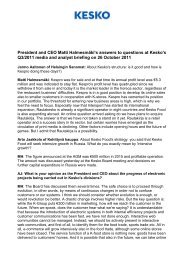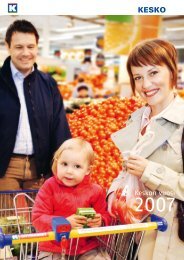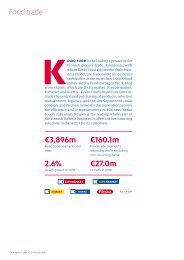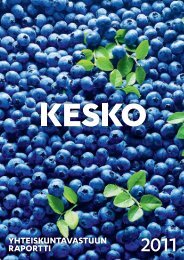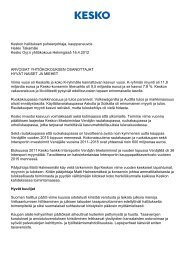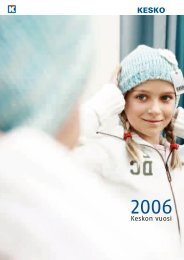Pdf version (3.2 MB) - Kesko
Pdf version (3.2 MB) - Kesko
Pdf version (3.2 MB) - Kesko
You also want an ePaper? Increase the reach of your titles
YUMPU automatically turns print PDFs into web optimized ePapers that Google loves.
the new energy efficient concepts developed<br />
by Rautakesko and its partners.<br />
“K-rauta Lahti's air tightness value was<br />
0.4 1/h and K-rauta Uppsala's was 0.2 1/h.<br />
These are very good results, because values<br />
between 0–1 on the scale for one-family<br />
houses, for example, mean 'very tight', those<br />
between 2–5 are 'normal' and over 10 means<br />
'very leaky',” says Rautakesko's Building<br />
Manager Petri Mörk.<br />
STORE REFRIGERATION<br />
EqUIPMENT MAKES USE OF<br />
CARBON DIOxIDE<br />
The cooling of chest freezers and other<br />
refrigeration equipment generates condensation<br />
heat which can be used for heating.<br />
The condensation heat from cooling units is<br />
recovered in nearly all K-food stores. These<br />
stores only need additional heat energy in<br />
very low sub-zero temperatures.<br />
Nowadays, increasingly many K-food<br />
stores save energy also by using carbon<br />
dioxide recovered from industry processes<br />
as refrigerant.<br />
“Recovered carbon dioxide is a safe refrigerant<br />
and it does not deplete the ozone layer<br />
like freons, which were used earlier but are<br />
forbidden today. The stores using carbon<br />
dioxide as refrigerant consume 30% less<br />
heat energy than stores using other refrigerants,”<br />
says Maintenance Manager Jari<br />
Pihlajamaa of <strong>Kesko</strong> Food.<br />
GROUND HEAT AS A SOURCE OF<br />
HEAT IN ONE-FAMILy HOUSES<br />
AND SHOPPING CENTRES<br />
In recent years, ground heat pumps have<br />
become increasingly popular as heating<br />
systems. In 2011, ground heat was chosen<br />
for some 45% of new buildings. Ground<br />
heat pumps utilise the solar energy stored<br />
just beneath the ground surface or water<br />
systems.<br />
K-rauta displayed ground heating and<br />
other housing solutions which save energy<br />
at its stand at the Housing Fair in Kokkola<br />
in summer 2011.<br />
Eco point pilot also accepts<br />
plastic packaging<br />
The waste legislation to be enforced at the beginning of May<br />
2012 will change producers' liability for packaging and set<br />
new requirements on the organisation of packaging recovery<br />
by consumers. <strong>Kesko</strong> Food is participating in the Eco<br />
Point Pilot research project on household waste run by the<br />
packaging producer communities, the trading sector and<br />
municipal waste treatment plants from January 2012 until<br />
August-September 2012.<br />
Five K-food stores in the Tampere and Kuopio areas are<br />
involved in the project. The project is aimed at establishing<br />
ClIMaTE CHaNgE<br />
The ongoing climate change, which is the result of human activity, is primarily<br />
caused by the increasing amount of greenhouse gases, especially carbon<br />
dioxide (CO 2 ), in the atmosphere. If emissions continue to grow at the current<br />
rate, the accelerating greenhouse effect will raise the global average temperature<br />
by approximately 2–6 degrees by the end of the century. About one third<br />
of emissions are produced by housing, one third by transport and the rest by<br />
food and other consumer products.<br />
Source: The Finnish Meteorological Institute, the Finnish Environment Institute<br />
(SYKE).<br />
“Residents of one-family houses are very<br />
familiar with ground heat by now. It was<br />
in record demand in 2011. Hybrid heating<br />
solutions and solar energy in particular are<br />
expected to become increasingly popular,”<br />
says Sales Manager Vesa Saarenheimo of<br />
Rautakesko.<br />
A ground heating system was adopted<br />
at the Veturi shopping centre in Kouvola<br />
already at the construction stage. Half of the<br />
cooling and heating power of the shopping<br />
centre is derived from the ground. Veturi<br />
also uses a carbon dioxide system for the<br />
store refrigeration units.<br />
“In the summer, Veturi is cooled with<br />
ground cooling and, in the winter, the same<br />
holes convey ground heat. The shopping<br />
centre only needs district heat in very low<br />
sub-zero temperatures. Veturi is situated on<br />
a rocky, 14-hectare site with yard areas sufficient<br />
for accommodating about 130 cooling/<br />
heating wells. This gave us an opportunity<br />
to adapt new technologies to our store site<br />
construction. Not only does the shopping<br />
centre benefit from them, but it also gives us<br />
useful information for our future projects,<br />
says Building Contractor Manager Seppo<br />
Kemppainen of <strong>Kesko</strong> Food.<br />
Read more about Veturi on page 17.<br />
ClIMaTE CHaNgE WORK<br />
STORES ENHANCE THEIR ENERGy<br />
CONSUMPTION IN MANy WAyS<br />
Energy management and energy efficiency<br />
are emphasised in K-stores by means of<br />
maintenance operations and continuous<br />
monitoring conducted jointly by retailers.<br />
The store site maintenance organisation<br />
has been trained for effective energy<br />
management.<br />
The biggest energy savings in stores are<br />
achieved by providing chest freezers with<br />
lids, by ensuring correct use of technical<br />
systems and by using LED illuminated signs.<br />
The refrigeration equipment of all new<br />
K-food stores has lids and doors. The total<br />
length of lids and doors on K-food stores’<br />
refrigeration equipment is nearly seven<br />
kilometres.<br />
In 2011, K-food stores added doors to<br />
their juice and dairy cabinets. K-citymarket<br />
Hämeensaari, opened in early September,<br />
was one of the first stores to have doors on<br />
dairy cabinets.<br />
“We are very satisfied with our dairy cabinets<br />
with doors. Protecting the environment<br />
also saves money. The annual saving in electricity<br />
achieved by this is about 30% compared<br />
to not having doors on the cabinets.<br />
An even temperature enabled by doors also<br />
a recovery network and<br />
an operating model<br />
for discarded consumer<br />
packaging which would be efficient in respect of the<br />
environment and costs and fulfil the requirements of the new<br />
waste legislation.<br />
Eco Point Pilot encourages customers to return their<br />
sorted household waste to the eco points at stores during<br />
shopping trips. In addition, the pilot point also accepts consumers'<br />
plastic packaging. The eco points will continue to<br />
collect other sorts of waste, such as cardboard, glass and<br />
metal, as before.<br />
<strong>Kesko</strong> Corporate Responsibility Report 2011 25




